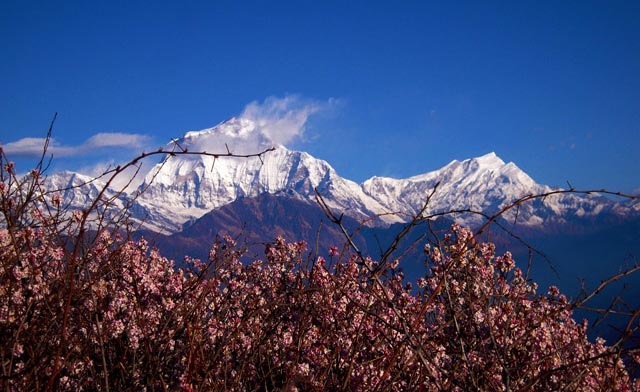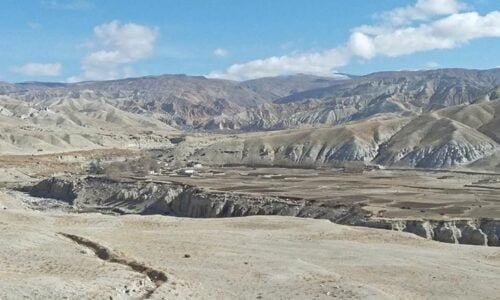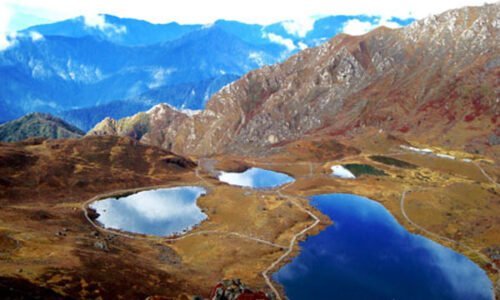A Complete Guide for Annapurna Region Weather
4 May 2023 5 min to read
Outdoor Himalayan Treks present the article “A Complete Guide for Annapurna Region Weather”. The Annapurna region in Nepal is a popular destination for trekking, offering a diverse range of options for adventure enthusiasts and nature lovers of all fitness levels. The area is acknowledged for its natural beauty, rich biodiversity, and diverse culture, with several ethnic groups inhabiting the region, each with its unique customs, traditions, and language.
The Annapurna region also boasts ancient monasteries, temples, and shrines, showcasing its rich religious history. Additionally, the area is famous for its abundant flora and fauna. For those interested in trekking, culture, and nature, the Annapurna region is a must-visit destination. Popular trekking routes in the region include the classic Annapurna Base Camp Trek, the Annapurna Circuit Trek, the Ghorepani Poon Hill Trek, the Jomsom Muktinath Trek, and the Upper Mustang Trek.
Many factors play a vital role during Annapurna region treks and one of them is the weather. Different four seasons offer different views with their weather patterns and stunning scenery. And the beauty of the Annapurna region is unparalleled. Below is a complete guide for Annapurna Region weather in the four seasons and what it offers:

Spring (March to May) in Annapurna region
The best season for Annapurna region treks is the Spring season. During this season, the weather is mild, and the region is full of blooming rhododendrons and wildflowers. The temperature is warm during the days and slightly breezy and chill during the nights. The trails are comfortable to walk with clear skies and pleasant scenery. Since it is the best season, it is also crowded.
Spring Day Temperature: 15°C to 25°C
Spring Night Temperature: 5°C to (-10°C)
Springs In:–
March: Day: 10°C to 12°C, Night: 4°C to (-8°C)
April: Day: 15°C to 20°C, Night: 8°C to (-4°C)
May: Day: 17°C to 25°C, Night: 0°C to 5°C
Sunshine Hour Daily: 7-8 hours
Humidity: Relatively Low
Wind Speed: Relatively Low
Accommodation: Abundant Teahouses/Luxury Hotel
Meals: From basic Dal-Bhat to a variety of options (eggs, pancakes, pizza, coffee, etc.)

Autumn (September to November) in Annapurna region
Autumn is considered the second-best season to trek in the Annapurna region. The clear skies, moderate temperatures, and breathtaking views of the mountains are ideal for trekking. This is the festive season in Nepal, so get a warm welcome from the locals and enjoy their hospitality with local cuisine. Throughout the treks, enjoy the scenic landscapes, and the panoramic mountain vistas.
Autumn Day Temperature: 15°C to 17°C
Autumn Night Temperature: 5°C to (-10°C)
Autumns In:–
September: Day: 10°C to 15°C, Night: 5°C to (-7°C)
October: Day: 10°C to 17°C, Night: 4°C to (-5°C)
November: Day: 10°C to 12°C, Night: 5°C to (-10°C)
Sunshine Hour Daily: 7 hours
Humidity: Relatively Low
Wind Speed: Relatively low
Accommodation: Abundant Teahouses/Luxury Hotel
Meals: From basic Dal-Bhat to a variety of options (eggs, pancakes, pizza, coffee, etc.)

Monsoon (June to August) in Annapurna region
Monsoon season is not considered favorable as the trails are muddy and slippery due to heavy rainfall. But, the rainfall brings out the lush greenery which is eye-pleasing. The views are also mostly hidden by clouds and navigating the trail is also difficult. Most of the teahouses at higher altitudes remain closed which makes it tough to find suitable accommodations and meals. In the Annapurna region, Manang and Upper Mustang regions are exceptional and can expect less or no rainfall but a few snowfalls at higher altitudes. During monsoons, these destinations can be the best choice for the Annapurna region treks.
Monsoon Day Temperature: 15°C to 20°C
Monsoon Night Temperature: 0°C to (-5°C)
Monsoons In:–
June: Day: 10°C to 17°C, Night: 6°C to (-4°C)
July: Day: 10°C to 12°C, Night: 4°C to (-5°C)
August: Day: 10°C to 20°C, Night: 8°C to (-3°C)
Sunshine Hour Daily: 5-6 hours
Humidity: High
Wind Speed: Moderate to Strong as elevation rises
Accommodation: Very Limited Teahouses
Meals: Very Limited Meal options

Winter (December to February) in Annapurna region
Winter season is very cold and expect heavy snowfalls in the higher elevations. Despite the chilly weather, the skies are clear and offer spectacular views of snow-capped mountains. Winter is not the preferred season for trekking in the Annapurna region due to its shorter days, increased risk of avalanches, and limited facilities as most of the teahouses and lodges are closed. The unpredictable weather, snowfall, and cold temperatures make it challenging to trek during this time. However, for those seeking adventure, it is possible to trek during the winter season by taking proper safety measures and consulting with experts. It is important to note that trekkers should take full responsibility for their safety during winter treks.
Winter Day Temperature: 5°C to 10°C
Winter Night Temperature: 0°C to (-25°C)
Winters In:–
December: Day: 5°C to 10°C, Night: 0°C to (-25°C)
January: Day: 7°C to 10°C, Night: 0°C to (-15°C)
February: Day: 7°C to 12°C, Night: 0°C to (-15°C)
Sunshine Hour Daily: 6-7 hours
Humidity: Low
Wind Speed: Moderate to Strong as elevation rises
Accommodation: Very Limited Teahouses
Meals: Very Limited Meal options
To ensure a safe and enjoyable trek in the Annapurna region, it is essential to be prepared for unpredictable weather changes, especially at higher altitudes. Regularly checking weather forecasts and consulting with local guides or trekking agencies is recommended. Packing appropriate gear for all weather conditions is crucial regardless of the time of year. Seeking advice from travel agencies for comprehensive lists of necessary clothing and materials is also useful. These practical measures enable trekkers to be fully prepared for any situation and have an unforgettable experience in the Annapurna region, regardless of the season.





